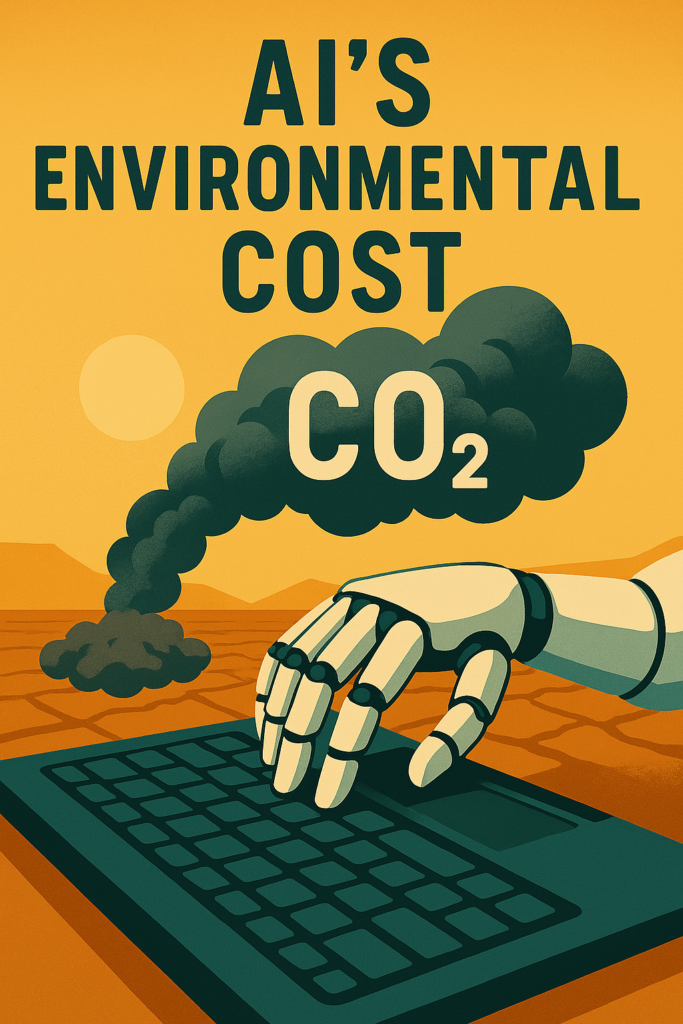In short:
- Training large AI models consumes a staggering amount of energy.
- The carbon footprint of developing and running AI models like GPT-4 is comparable to multiple cars’ lifetime emissions.
- Server farms powering AI are often fueled by non-renewable energy sources.
- There is a growing need for sustainable AI development practices.
- A balanced perspective is essential: AI has tremendous benefits, but its hidden environmental costs must be addressed.
AI Is Not Magic — It’s Megawatts
When we interact with AI — from voice assistants to image generators and chatbots — it often feels like magic. But this “magic” is actually powered by an enormous network of data centers, computing clusters, and massive energy consumption. Behind the seamless responses of a model like GPT-4 lies an intricate web of GPUs, cooling systems, and electricity-thirsty servers. And as artificial intelligence becomes more deeply embedded in our lives, the question arises: at what environmental cost?
This blog explores the often-overlooked ecological footprint of artificial intelligence. We’ll look at how much energy AI consumes, what contributes to this demand, and how the industry can balance innovation with sustainability.
Why AI Is So Energy-Intensive
Training AI models is not the same as running everyday software. Large language models (LLMs), like OpenAI’s GPT-4, require:
- Millions of Parameters: GPT-4 reportedly has over 1 trillion parameters.
- GPU-Driven Processing: The model is trained on GPU clusters that run continuously for weeks or months.
- Massive Datasets: Training involves ingesting data from the entire internet.
Example: Training GPT-3 required 1,287 MWh of electricity. That’s enough to power an average U.S. home for over 120 years.
The Carbon Footprint of AI
Training just one large AI model can emit more CO₂ than five cars over their entire lifetime. The following factors contribute:
- Energy Source: If servers are powered by coal-based electricity, the emissions are significantly higher.
- Cooling Needs: Data centers must be kept cool, which adds further power consumption.
- Inference Operations: Even once trained, every interaction with the model consumes energy.
In Perspective:
- GPT-3’s training alone released 552 metric tons of CO₂.
- Running AI models across the world daily adds layers of ongoing emissions.
How Big Tech Powers Its AI
Major tech companies like Google, Amazon, Microsoft, and Meta host their AI models in gigantic data centers around the world.
- Data Center Locations: Often based in cooler climates to reduce cooling costs.
- Renewable Commitments: Some firms have pledged to use 100% renewable energy, but not all operations meet this.
- Carbon Offsets vs. Reductions: Offsetting is not the same as reducing emissions at the source.
Example: Google claims to operate on carbon-neutral energy, but emissions from hardware production and power backups are rarely included.
The Inference Problem: Energy Doesn’t Stop at Training
Most of the energy debate focuses on training, but inference (the actual use of the model) can outpace training over time.
- Each chatbot query uses significant computational power.
- Billions of queries daily equate to constant GPU usage.
- Image generation and video synthesis consume even more energy.
Consider This: If 1 billion people used ChatGPT once a day, the energy impact would be comparable to a mid-sized country.
Not Just Emissions: The Broader Environmental Impact

AI development also involves:
- Rare Earth Minerals: Mining for components like lithium, cobalt, and gold.
- Water Usage: Cooling systems often use vast amounts of water.
- Electronic Waste: Constant hardware upgrades lead to e-waste.
Case Study: A single data center can use up to 5 million gallons of water per day for cooling.
The Benefits AI Brings (And Why It’s Worth Balancing)
Despite these concerns, AI offers transformative benefits:
- Climate Change Modeling
- Precision Agriculture
- Healthcare Diagnostics
- Energy Optimization
AI is a double-edged sword: it consumes energy, but it can also help optimize energy usage and monitor environmental conditions.
Emerging Solutions: Green AI and Sustainable Practices
To reduce AI’s environmental impact, researchers and companies are exploring:
- Efficient Model Training: Smaller, optimized models trained on fewer data.
- Low-Power Hardware: Development of AI chips that consume less energy.
- Edge Computing: Processing data locally reduces need for server usage.
- Renewable Energy Integration: Powering data centers with solar, wind, and hydro.
Notable Examples:
- Hugging Face and EleutherAI focus on open-source, efficient models.
- Microsoft aims to be carbon negative by 2030.
Policy, Ethics, and Regulation
Governments and global organizations are starting to regulate:
- Carbon disclosures for AI training
- Eco-labels for sustainable software
- Data center efficiency standards
Question: Should companies be required to disclose the environmental cost of their models?
What Can Developers and Users Do?
Individual responsibility matters too:
- Choose sustainable platforms
- Limit unnecessary AI usage
- Support efficient tools and libraries
- Educate about energy implications
If demand shifts towards greener tools, companies will adapt.
Conclusion: The AI Paradox
AI is one of the most powerful tools humanity has created, but it’s not without cost. The dazzling abilities of large language models and generative AI come with a hidden environmental price tag that can no longer be ignored. Balancing the promise of AI with our planet’s health is not just possible — it’s essential.
By embracing sustainable practices, pushing for transparency, and innovating smarter, the tech world can continue to build powerful AI systems without destroying the environment they operate in.








+ There are no comments
Add yours